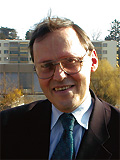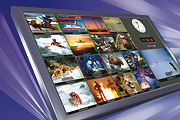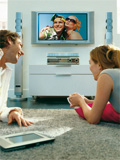Influential ITU standard marks 25th anniversary
Recommendation 601 drives digital television worldwide
| |
 Contributed by David Wood Contributed by David Wood
Mr Wood is Head of New Technology at the European Broadcasting Union (Geneva)
and was the Chairman of CCIR IWP 11/4, ITU–R Working Party 11A
ITU |
Hundreds of millions of digital television sets across the world today operate
on the basis of an ITU Recommendation that marks its 25th anniversary this year.
Analogue television will close down over the next ten years across the world, and
eventually 4 or 5 billion viewers will be watching digital pictures based on Recommendation
601. It formed a bridge between the analogue and digital worlds and has been the
most quoted and used technical document in the history of television.
Facilitating the development of digital television has been the task of the ITU
Radiocommunication Sector (ITU–R) and of its predecessor, the International Radio
Consultative Committee (known under its French acronym, CCIR). In the autumn of
1981, CCIR Study Group 11 approved a document describing the parameter values for
a digital video format. In February 1982, the CCIR Plenary Assembly approved this
document as Draft Recommendation AA/11 “Encoding Parameters for Digital Television
for Studios”. This eventually became ITU–R BT Recommendation 601. I had the privilege
of chairing the drafting group that prepared the Recommendation a quarter-century
ago, and I took part in the international negotiations that led to its adoption
by CCIR.
Recommendation 601 (as it is often called) is now in its sixth version (ITU–R
BT. 601-6) under the title “Studio encoding parameters of digital television for
standard 4:3 and wide screen 16:9 aspect ratios”. It is the basis for not only standard
quality video, but also the higher quality forms of 720p, 1080i, and 1080p. Thus,
the application of the Recommendation will stretch far into the future.
The dawn
of digital television
The first experiments in digital technology for television in the 1970s took
the existing composite analogue PAL, SECAM, and NTSC signals and made digital
versions of them. This was called “digital composite coding”.
|

Miranda Technologies |
|
An important technical parameter was the choice of “sampling frequency”, or the
rate at which the analogue signal is examined and converted to digital numbers.
However, it was impossible to find a single sampling frequency that would suit PAL,
SECAM, and NTSC at the same time, because of the way these systems had been developed.
Applying the technique of digital composite coding would have led to different digital
television production systems being used in different world regions, and eventually
to different digital broadcasting standards.
| |

Miranda Technologies |
| |

Philips |
A first breakthrough came in Europe in 1979 with the agreement to use a unique
digital system, “digital component coding”, for both PAL and SECAM. It was the result
of discussions between studio equipment manufacturers and broadcasters, culminating
in an agreement at a meeting at the Television Symposium in Montreux, Switzerland. In digital component coding, the different parts of the television
picture (the “luminance” and “colour difference” signals) are treated separately,
rather than together as they are in digital composite coding. One of the greatest
advocates of digital component coding was Chris Clarke of the British Broadcasting
Corporation (BBC).
The PAL and SECAM worlds initially proposed a single digital component coded
system with a sampling frequency of 12 MHz for the luminance signal (Y) and 4
MHz each for the two colour difference signals (U and V). However, it remained for
NTSC countries to decide a digital production standard. Pioneers such as Joseph
Flaherty of the US broadcaster CBS had the foresight to recognize what would be
gained if not just PAL and SECAM had a common system, but the NTSC world adopted
digital component coding too. But, for such a system, the United States and Canada
preferred a higher sampling frequency of 14.3 MHz (Y) and 7.15 MHz (U,V). It soon
became clear that only if both sides compromised would an agreement be reached.
The magic number
A number of factors affected the choice of a worldwide sampling frequency: the
picture quality had to be good enough (“quality transparency with the source”),
and the digital signal had to be capable of withstanding the various processes of
television post-production (“quality headroom for post-processing”). In addition,
the choice had to suit the world’s two different structures for television pictures:
525 lines with 60 fields per second (525/60) and 625 lines with 50 fields per second
(625/50). The quality transparency requirement seemed to be met by a sampling frequency
of 12 MHz and above, but achieving the second objective — quality headroom for post-processing
— needed 13 MHz or more. For the PAL and SECAM worlds, the number needed to be as
close as possible to 13 MHz.
Several people worked on this problem, and many came up with the same idea: the
magic number was
13.5 MHz. However, the father of the idea, and the first to propose it, was Stanley
Baron of NBC.
Of all possible sampling frequencies for the luminance signal, 13.5 MHz has a
unique property: it is a common multiple of the line frequencies of both the 525/60
and the 625/50 scanning structures. This means that the sampling pattern is “stationary”
and “orthogonal” in both cases, and both systems can be arranged to have another
common element: the same number of samples per active line. The best combination
for convenience, quality, and post processing capability was thus 13.5 MHz (Y) and
6.75 MHz (U,V).
In truth, a very important point was that the sampling frequency favoured no
particular side in the debate. One by one, the world’s Broadcasting Unions supported
it. The last piece fell into place in 1982 at a meeting of CCIR Study Group 11,
when Japanese participant Mr Y. Tadokoro from the broadcaster NHK announced that
his country could accept 13.5 MHz. He and his team had worked hard to achieve a
laboratory analysis of sampling frequencies in an incredibly short time, so allowing
Japan to agree.
Seizing the day
The agreement at CCIR was the result of an enormous effort by numerous people.
There were laboratory tests of parameter values in many parts of the world, and
there was much travel, by me and others, to explain at length why the proposed values
were the best compromise. So many people were involved in achieving this success,
that it is impossible to name them all. Risking their anger by mentioning just a
few, I recall Richard Green, who led the United States team, and the late Howard
Jones and Jacques Sabatier from Europe. Also, I cannot fail to mention the remarkable
Chairman of CCIR Study Group 11, Professor Mark Krivocheev, who did so much to ensure
the success of the project. Finally, the unsung heroes of ITU, the secretariat,
must be applauded. There was no easy way to obtain agreement, just very thorough
preparation and fairness throughout the process. |
In recognition of the importance of Recommendation 601, ITU received an “Emmy”
award in 1983, for developing a common world standard for digital television.
A “Technology and Engineering Emmy” is given by the National Academy of Television
Arts and Sciences, of the United States, for outstanding achievement in those fields.
|
| Twenty-five years ago, Recommendation 601
was the right result, achieved at the right time, in the right way.
Through hard work and cooperation, we were able to “seize the day” and
help create a common digital system for television around the globe.
|

Professor Mark Krivocheev,
then Chairman of CCIR Study Group 11
ITU |
|


